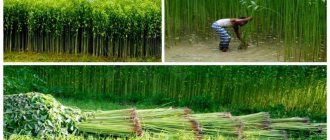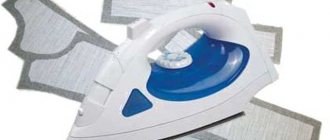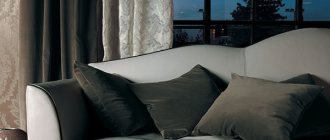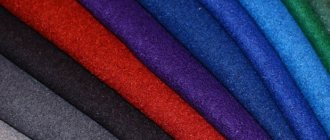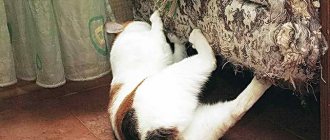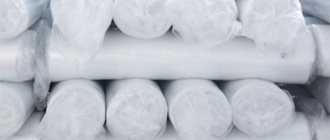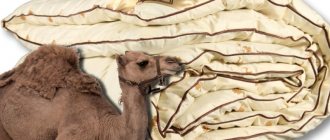Wooden houses made of solid wood are not losing their popularity. In our time of high construction requirements, this indicates the enormous technical and consumer potential of log houses. In order for a cottage made of timber or logs to be truly energy efficient, it is necessary to especially carefully select inter-crown insulation and approach its use with all responsibility. In the article we will consider the basic rules for using jute insulation as the most suitable for wooden construction.
Production of jute insulation
What does jute insulation look like?
Most often, the material looks like a voluminous roll of golden-colored tape. Its width is 15–20 cm. If you unfold the insulation, you can see a rough pile. Plant fibers can be compressed or simply combed. The most common thickness of the canvas is 0.5–1 cm.
Jute is a plant native to Asia. It is widely used in textile production: bags, ropes, insulation and much more are made.
Where is jute used?
Jute was originally used to make fabrics and strong ropes for building houses and boats. Scientific and technological progress has significantly expanded the possibilities of its use. Today, home textiles are made from it, including carpets and garden decor items, packaging material, insulation materials, etc. Jute is a popular element of ethnic-style interiors.
Manufacturing of ropes and ropes
Strong fibers are ideal for making ropes, twine and ropes, but they are highly sensitive to ultraviolet radiation and heat, so they are treated with special impregnations. This allows the use of ropes and ropes in harsh climates and in industry: in mechanical engineering, aviation, marine industries, in textile production - for the manufacture of equipment for rescuers, etc. Using jute ropes, interiors are decorated and cracks are sealed (see photo).
Jute seals: types, pros and cons
Jute seals are used both for insulating wooden beams and for sealing holes in walls, door and window openings. Types of jute seals:
- Tow. Made from 100% jute, which allows you to preserve the natural structure of jute fiber. Density – up to 600 g/sq.m. m, which is why it is called thermojute. Due to its increased hygroscopicity, tow is most often used to seal cracks in bathhouses. Available in rolls or bales.
- Felt. In addition to jute, felt contains 10–15% flax. This sealant has even greater strength than tow. Jute felt is the most aesthetically pleasing, but at the same time it is the hardest and most crumbling. Using jute felt, you can insulate houses, window and door openings without caulking. Available in rolls.
- Flax-jute. The equal amount of jute and flax in the composition makes this material at the same time durable, soft and elastic enough to seal the narrowest crown grooves. Available in rolls.
The popularity of jute seals is due to such advantages as:
- aesthetics;
- environmental friendliness;
- good breathability, allowing you to maintain a comfortable microclimate in the house;
- high tightness;
- resistance to deformation (applies to felt and flax-jute), thanks to which it retains its shape for many years;
- protection from birds - short fibers are almost impossible to grab with your beak and pull out of the holes between the logs;
- affordable price.
Disadvantages of jute seals:
- relatively short service life - under the influence of moisture the seal begins to rot;
- rapid loss of performance characteristics (applies to low-quality material with the addition of moss or recycled burlap);
- easy flammability;
- a certain complexity of installation due to the rigidity of the material;
- the need for additional caulk (tow) to avoid “blowing out” the house.
Rough fabric
Coarse fabric, or burlap, is made from thick fibers. This type of jute is characterized by a textured surface and causes unpleasant tactile sensations, therefore it is rarely used for sewing clothes.
Most often, coarse fabric is used to make bags, packaging, which is used not only for transporting things, but also for decorative purposes, covering materials to protect shrubs and trees from the cold, and cleaning materials for industrial needs.
Where is it used?
Natural insulation is widely used in the construction of houses. The material fills the inter-crown space. It is often called “inter-crown jute” (“crowns” is the traditional name for wall logs). For installation, a piece of suitable size is torn off from the tape.
Jute insulation is used for wooden structures - bathhouses, log houses and houses made of timber. It is highly effective in terms of thermal protection, does not change the properties of wood and protects it from biological destruction.
Due to the content of resinous substances, jute is resistant to moisture and has antibacterial and antifungal properties.
Jute for laying crowns
jute is becoming increasingly popular . Felt and tow, made from the fibers of the annual plant of the same name, are replacing traditional moss with might and main. Jute, like moss, has been known to mankind for a very long time. Since ancient times, fiber has been produced from the stems of this plant, which was used for the production of durable, coarse fabrics, ropes, mats and other useful things, but even in our time, jute has not lost its value. To insulate the inter-crown space, jute tape is now being produced - a modern and easy-to-use felt-like material made from jute fiber with the addition of a certain amount of flax to give the material additional strength and flexibility. Using this tape is very simple - just roll it out and secure it with construction clips in the bowl of the log and place the crown in place.
What is good about jute? Although it is not superior to moss in terms of heat retention, it is not inferior to it. If the jute production technology is not compromised in any way, it is also no less environmentally friendly than sphagnum or cuckoo flax. Jute significantly reduces the time spent on building a log house, is very durable, hygroscopic and contains the substance lignin in its fibers, which prevents rotting of both the insulation material itself and the wood.
In ordinary log houses, the use of felt jute tape is not very practical, because... the homogeneous structure of this material, unlike moss, is unable to adequately fill all the irregularities and cavities of the log, which, in turn, can lead to some heat loss in the room. However, if you use a rounded log, profiled or regular timber for assembly, the jute tape performs best, perfectly filling flat surfaces and, again, speeding up the assembly time. So which is better, flax or jute? We will probably never get a definite answer, but we have nevertheless come to certain conclusions.
For classic hand-cut log houses, building houses and bathhouses of an old design, moss in combination with flax tow is still best suited, but for rounded logs and timber you can safely use jute tape, flax-jute, and, of course, the same moss. High-quality insulation of log walls will allow you not only to enjoy warmth and comfort on long, winter evenings, but also to significantly save on heating the room, consuming less electricity or gas. In an era of endless tariff growth, this may turn out to be a good insurance against unnecessary expenses in the future. In any case, it will never hurt to consult with a practitioner who has experience working with all the mentioned insulation materials and building materials, and only after that start building your favorite home!
Technical characteristics of jute insulation
Jute thermal insulation can have different technical characteristics depending on what shape it has and what fillers were used. Let's consider the properties of felt insulation, which is used most often:
- Thermal conductivity
. According to this indicator, jute is close to polystyrene foam. Its thermal conductivity is only 0.035-0.036 W/m/K. - Moisture absorption
. For jute felt this figure is within 1%. This means that it can be safely used to insulate structures where there is high humidity. - Surface density
. For the material it is on average 30 kilograms per cubic meter. - Flammability
. Jute belongs to class G4, that is, it is a highly flammable insulation material that has a smoke temperature of over 450 degrees Celsius. The material can independently support combustion for more than three hundred seconds. - Vapor permeability
. This indicator for jute insulation is about 0.3 mg/(m*h*Pa). That is, the heat insulator can almost freely pass steam outside and outside. - Soundproofing
. Jute felt can absorb sounds from low, mid and high frequencies. Belongs to the NSV-211 class. - Environmental friendliness
. The material does not emit any harmful compounds and does not attract birds, insects and rodents. It is convenient to work with it, as it does not generate dust and does not require the use of personal protective equipment. - Lifetime
. According to recent studies, the shelf life of insulation for jute beams is comparable to the durability of the wooden structure itself.
Production of jute fiber and fabrics from it
Jute matures within 4–5 months, after which the harvest begins. The cut stems are left in the field for several days to allow the leaves to fall, after which they are soaked in water for 1–2 weeks. In this way, the adhesive components are destroyed, and the fibers are easily separated from the stem during subsequent processing of the raw material. Next, the jute is washed, dried and sorted according to criteria such as length, elasticity and color, pressed and sent to textile production.
Stages of jute fiber production:
- Loosening the bales of jute stems received at the factory in a bale breaker.
- Softening the stems by soaking them in water, oil solutions and other substances. In this case, especially hard areas with lumps must be carefully processed.
- Mechanical softening of stems by processing in a grinder. Lumps that could not be softened with liquid and the tops are first removed. The removed particles are subsequently used to produce lower grade fibers.
- Pre-spinning – cleaning raw materials from dust and dirt, separating, straightening and folding fibers into ribbons.
- The jute is combed in 2–3 draw frames, depending on the thickness of the fibers, in which they are further straightened and thinned.
- Processing of jute in a spinning frame in which the roving is converted into yarn. Rolling of jute fibers into rolls and transfer to weaving departments for fabric production.
Advantages of jute insulation
Among all inter-crown heat insulators, jute has a number of advantages that are unique to it. Let's look at them:
- Bonding ability
. Jute contains lingin in large quantities. It is a natural resin that prevents rot and mold. In addition, it is capable of gluing fibers and timber together, making the seam airtight. - High rigidity
. This quality is responsible for the fact that jute practically does not wrinkle over time, which means it does not lose its thermal insulation characteristics. - Highly environmentally friendly
. Good quality material contains exclusively natural components, so jute cannot emit any toxic volatile compounds during operation. - Easy to install
. To lay jute in the inter-crown space, you do not need any special tools. All work can be done independently. The material does not emit dust and does not irritate the skin and mucous membranes. - Good vapor permeability
. This quality guarantees that an optimal climate will be maintained inside the building. - Versatility
. Felt jute, thanks to its good compressive resistance, can be used to insulate not only seams in wooden houses, but also floors, walls, and roofs. - Aesthetics
. The material has a golden natural color that matches perfectly with the color of natural timber or logs. Therefore, no additional decorative processing of jute is required.
The concept of plant tissues, their characteristics, what they consist of
Properties
Canvas of plant origin is an expensive material with excellent hygienic properties, which are so valued in clothing. Thanks to this, the products not only look attractive, but are also comfortable to wear. But the most important property of plant tissues is their hypoallergenicity, which will undoubtedly please people prone to allergic reactions.
To improve properties, artificial fibers can be added. Thus, a fabric is obtained that has the advantages of natural and synthetic raw materials.
Appearance
Each material has its own distinctive appearance features:
- Silk has a smooth and glossy surface, but the material can be patterned.
- Cotton (cotton) is soft, thin and matte. The color is white, with a slight cream tint.
- Wool has a rough surface and elastic fibers.
- Linen has a smooth, matte outer surface.
Disadvantages of jute insulation
The main disadvantages of this thermal insulation material include the following:
- Relative fragility
. Since jute is a completely natural material, its service life is short. And if wood can be coated with protective compounds, then the insulation will have to be changed from time to time. - Reduced thermal insulation qualities when wet
. Although jute is difficult to wet, if it absorbs moisture, its thermal conductivity increases sharply. It takes a very long time to dry. For the same reason, it cannot be installed in wet weather. - The need for caulking
. To prevent cold air from blowing through and entering the room, the building must be additionally caulked.
Natural thermal insulation materials
Natural heat insulators include:
- moss;
- flax - represented by tow, felt and batting;
- jute in the form of felt and tow;
- jute-linen (mixed tape insulator);
- natural felt (made from sheep's wool) is a new product on the construction market.
Moss
Moss is one of the oldest insulation materials for the gaps between the logs of wooden buildings. However, working with such heat-insulating material is more difficult than with tape heat insulators. But sometimes it is irreplaceable:
- the financial capabilities of the developer are limited - the material is obtained for free, albeit with great effort;
- the house is built from hand-cut pine trunks - it is convenient to select the thickness of the insulation to match the diameter of the log;
- the owners have chronic respiratory diseases - it releases phenolic and triterpene substances into the air, which have a healing effect on sick family members.
What is the material made of?
Jute is made from a special plant that is grown in Southeast Asia.
Successful cultivation of jute is possible only in regions with a hot, humid climate in marshy areas. In such conditions, the plant forms dense green masses reaching 4 m in height. Growth and formation of an adult subshrub is completed in 4-5 months.
Collecting and processing green mass is hard manual labor. It consists of several stages:
- cutting stems;
- formation of connected sheaves;
- keeping them on the field for 3 days;
- soaking in water for two weeks;
- separation of bast fibers from the base of the stem;
- drying them while hanging;
- sorting;
- bundling.
After the entire cycle of work has been carried out, the finished raw materials are sent to factories that produce fabric.
The cells of the bast part of plants have a specific structure. Their length is much greater than their width. The cell length is measured in millimeters or even centimeters, and the cross-sectional area is measured in microns. Elongated cellular structures are glued together by pectin substances, forming a strong association. The specific structure causes the formation of fibrillar strands of cellulose, partially twisted into spirals.
Jute fibers after isolation constitute only 20-25% of the primary mass of the plant.
The best option
The experience of professional builders shows that the optimal solution in terms of price/quality is a combined option - flax-jute or jute felt with admixtures of flax (sometimes other components). Jute gives the structure the necessary rigidity, and flax gives elasticity and elasticity. The ratio can be 10/90 or 50/50.
There are standards for using flax jute for different types of timber:
- For example, for a beam 150 by 150 mm, the width of the jute insulation should be 152 mm with a thickness of 5-8 mm;
- For chopped logs, wider felt with a width of 100-150 mm is used. In the case of a rare log house with a thickness of 250 mm and above, you can find strips of a similar width. For example, on the website of one jute manufacturer it is stated that, if necessary, you can cut ribbons up to 1600 mm wide.
What insulation materials are best suited for insulating the crowns of a log house?
Based on the above requirements, we can conclude that the best materials for inter-crown insulation of logs or beams are sealants made from natural materials.
Linen seals
There are two types of flax insulation suitable for inter-crown insulation - flax tow and felt.
Tow is a coarse fibrous waste from the primary processing of bast plants. Thanks to the uniformity of the fibers, it is easy to straighten and get rid of knots. But most often, tow is used for final caulking of inter-crown joints. Linen felt is used as the main material.
Linen tow.
Linen felt is a non-woven material based on flax fiber. Its other names are eurolinen, flax wool. Actually, felt and linen are different materials. Felt is made using needle-punched technology; its threads are randomly woven throughout the thickness of the layer with special needles. The batting is held together by stitching through the fabric with cotton or synthetic thread. For inter-crown sealing, needle-punched material is usually used.
Linen felt is used in the form of strips 5-20 mm thick and up to 150 mm wide. The thickness and width of the tape is selected depending on the width and profile of the timber.
Linen felt has a density of about 700 g/m2, the fiber composition includes: 80% cellulose, 5% lignin, 3% each of pectin and wax. Thanks to the presence of lignin, it is able to breathe and release excess moisture to the outside. The flax seal does not accumulate large amounts of moisture even with prolonged exposure to humid air.
Jute seals
Felt jute tape is similar to linen and is used in the same way. Jute is more resistant to rotting and birds are less interested in it. But it is tougher than flax and wrinkles worse, which must be taken into account when working. Jute fibers contain: 70% cellulose, 13% lignin, 0.2% pectin and 0.4% wax. Among the negative characteristics, it should be noted that jute has greater fragility and higher hygroscopicity. In addition, due to its foreign origin, this material is more expensive.
To improve the properties of the tape, from 30 to 50% flax fiber is added to jute. This is how jute-linen felt is obtained. In this case, the insulation combines the advantages of both materials.
To improve the quality and durability of insulation from non-woven tapes, lignin is added to them during production and antiseptic and fire-retardant treatment is carried out. Lignin is a natural polymer obtained from wood. It serves as an adhesive to hold the fibers together. Treatment with antiseptics and fire retardants compensates for the natural deficiencies of natural fibers.
Jute felt.
Seals in the form of a twisted cord made of jute fiber are used to seal joints from the inside after construction is completed. With their help, the joints are given a finished look and wood defects, which are especially visible at the edges of the crowns, are masked. Caulking with a cord performs mainly an aesthetic function. It is not used for timber frames due to narrow joints.
Moss
This is the oldest material used for sealing joints. Thin threads of moss create a dense, air-saturated mass with low thermal conductivity. Moss is valued for its ability to absorb and release moisture. In addition, it has antiseptic properties and is difficult to rot.
Currently, this material is not used because there are a number of sealants that are superior in their characteristics to moss. Moreover, the process of collecting and harvesting moss is very labor-intensive. It is very difficult to distribute in an even layer, and when completely dry, the moss becomes brittle, so it can only be used in a dried form. Previously, moss was indeed widely used to seal joints, but this happened only because there were no other materials.
How much does jute cost?
The price of flax jute depends mainly on density. The density is selected according to the project and largely depends on the weight of the structure lying on the insulation.
For example, well-known Russian jute felt is sold with a density of 250 g per m / p, thickness 2-4 mm (thin), 100 mm wide at a price of 4.5 rubles per meter, 150 mm wide at 6.5 rubles per linear meter. With a thickness of 4-6 mm, prices will increase to 5.7 and 8.55 rubles, respectively.
If the width of the strip for the log house is insufficient, the material can be laid in 2 layers. Material consumption increases and, naturally, so does the cost.
Also keep in mind that tape will be needed for insulation in the corners of window openings.
The table below shows the price depending on the volume of purchases and other types of insulation.
What should be the thickness and width of the jute tape?
The width of the jute tape depends on the chosen installation method, but it is recommended to order it so that it lies exactly along the thickness of the wall in the area where the crowns join. It is even better if it is 7-10 mm narrower than the thickness of the timber or log, since it will be slightly crushed under pressure. Obviously, for a two-layer hem job, you'll need twice the width.
If the house is made of profiled timber, then the tape is selected according to the width of the groove. This is easy to do, since jute tapes are produced in a variety of widths (usually in 2-centimeter increments).
For the correct choice of the thickness of tape jute, our own rules have been developed. Practice shows that there are more or less averaged optimal thicknesses of tapes laid in one layer.
- For walls made of glued and solid profiled timber, a tape with a thickness of about 4-6 mm is suitable, which will compress under load up to 2-3 millimeters.
- For walls made of dry planed timber and rounded logs, the best choice would be inter-crown insulation with a thickness of 8-10 mm, which shrinks to 3-5 mm.
- For walls made of chopped logs or edged beams with natural moisture, it is better to buy jute insulation with a thickness of 15 mm, which in the tightest places will have a thickness of about 5 mm, and when the load is removed, it can straighten to a thickness of approximately 1-1.2 mm.
For points 2 and 3, two-layer installation can be used. For them, tape thicknesses in the range of 4-6 mm and 7-10 mm, respectively, will be relevant.
Jute tape in a log house
Important! There is another important parameter - density. In other words, we need to be on guard so as not to buy “air”. Just a thick, but too fluffy tape will not provide the necessary thermal insulation, and when the load is removed locally and the frame shrinks unevenly, due to its low elasticity, it does not restore its shape as needed. Keep in mind that the density of each specific tape insulation depends on its original thickness, so at the moment an amendment is always made. The optimal density for insulating wooden houses is 300-400 grams per square meter with a tape thickness of 4-6 mm, 500-600 g/m2 for insulation with a thickness of 8-10 mm, and about 750-850 g/m2 for 15 - millimeter insulation material. As you can see, the relationship is not direct; the thicker the tape, the lower its specific density.
Insulation for a house made of edged timber
Linen and jute tow, batting and peat moss are used as inter-crown insulation for houses made of edged logs.
Moss is used to insulate baths and auxiliary buildings. For a residential building, flax or jute material is better suited; strips of batting or tape tow are laid between the crowns, corners and irregularities are caulked with tow. After shrinkage of the log house, additional “finishing” caulking of the seams is done from the outside and inside.
When asked which material is better, experts do not have a unanimous opinion. Jute fibers are more elastic, and linen fibers are soft and elastic; it is better to use flax as tow. When building from edged timber with roughly processed layers, it is recommended to use jute batting; for planed timber, linen insulation is recommended.
The best solution when choosing inter-crown insulation may be flax-jute batting; when constructing from three-edged timber or timber-laft, the inter-crown seams are additionally caulked with linen rope with a diameter of 20 mm.
A suitable method of laying tape inter-crown jute insulation
The most important factor influencing the use of a certain type of insulation and a certain method of its installation are the characteristics of the material from which the walls are made. To be more precise, the following are taken into account:
- The presence of local irregularities on the mutually touching surfaces of the crowns.
- Possible warping of lumber (relevant for edged and planed timber).
- The percentage of moisture in wood, which at high levels can cause more pronounced shrinkage of the house.
- Presence/absence of a profiled “lock” along the crowns of the log house.
- Wall height and others...
The more precisely the elements of the log house are adjusted to each other, the smaller the thickness of the insulating tape should be used. The greater the unevenness on the “working” surfaces of the timber and logs, and the greater the shrinkage with shrinkage, the thicker (for complete initial filling) the insulation should be and the more elastic (prone to straightening when the load is removed in order to fill possible voids that may appear) ).
Based on this principle, there are three ways to install tape for thermal insulation of joints: 1. Single-layer 2. Double-layer
- The tape is bent on one side (in half)
- The tape is folded on both sides (two bends are made from the edges)
Single-layer options are good if the quality of the wall material is high, but there are thick elastic tapes that can provide good insulation in one layer, for example, hand-cut crowns. Two-layer options are used only when you need to isolate large gaps and irregularities.
Important! Some craftsmen prefer in such cases (chopped logs) to combine ready-to-use tape compactors and materials that are supplied in bulk and are convenient for filling local unevenness. Sometimes, for the same purposes, tape felt (needle-punched fabric) is combined with tape tow (combed fabric), which easily stratifies in thickness.
Laying scheme for jute insulation
Interventional insulation for profiled timber
Houses made of profiled timber do not require caulking of the crown joints with tow; for insulation, a material with a tape width that follows the shape of the groove is used; in addition, this layer acts as a sealant. Manufacturers produce inter-crown insulation for the profile of any timber; the thickness and width of the material depend on the shape of the profile and the standard size of the timber. When purchasing corrugated timber for building a house, they immediately purchase a set of inter-crown insulation. Insulation is placed in the profile of blanks from house kits in industrial conditions.
Natural felt made from jute, sheep wool or “flax-jute” is used as insulation for profiled timber. After erecting a log house or assembling a house kit, to eliminate flaws, selective “finishing” caulking of the seams is carried out with flax tow.
Characteristics of woven jute
Jute fabrics are durable and resistant to deformation.
Most often, jute fabrics are made using plain weave threads. Only bast fibers or multicomponent compositions with the addition of cotton, linen, silk, lurex, and polymer threads can be used as raw materials.
The properties of jute fabric are as follows:
- high hygroscopicity;
- strength to tensile loads;
- resistance to deformation;
- ability to pass air;
- lack of tendency to electrify;
- good thermal insulation;
- unique texture;
- environmental friendliness;
- affordable price.
The introduction of additional threads from other raw materials can to some extent change the properties of the fabric. The qualities of jute with additives depend on the mass fraction of the latter:
- A material made only from jute fibers has some disadvantages. This fabric, especially low grades, is rough to the touch. It can be dry and brittle, exposed to putrefactive bacteria, and deteriorate when exposed to sunlight.
- The use of cotton as an additional raw material softens the fabric.
- Linen increases its bending strength.
Lamination of jute fabrics increases wear resistance; gives the material moisture resistance and the ability to keep its shape well. Various dyes adhere very well to such fabric. Dyed jute fabric with laminate has rich colors that do not change over time.
Do-it-yourself finishing caulk
After the log house has been subjected to shrinkage, finishing caulking is carried out at home. During the shrinkage process, the previously laid layer of insulation is deformed, voids can form in the inter-crown cracks, and vertical cracks can form in the corners of the frame. The operation is performed from the outside and inside. Caulking is a labor-intensive process that requires diligence and attention; the main tool is a wide wooden chisel or rubber mallet. To avoid damaging the integrity of the fibers, it is better to blunt the chisel. The operation begins with the lower crown along the entire perimeter, after caulking of the first crown is completed, they move on to the second, etc.
"Ancient" methods of insulation
You can also use simpler and long-used options. For example, use moss as insulation. Many species of this plant grow in nature, but only two varieties are best suited for insulating a wooden house:
- sphagnum - has a large amount of antiseptic substances. This feature allows you to reliably protect your home from the harmful effects of the environment;
- Kukushkin flax has less antiseptic effect. This moss is not laid completely dry, so its thermal insulation properties will be better.
Such insulation will help create a better microclimate in your home. This is created due to the aroma of the forest that the material emits. There will always be a pleasant atmosphere in your home.
Ordinary moss - sphagnum - can be used as inter-crown insulation.
The moss itself is environmentally friendly and does not cause allergies. But assembling it yourself is quite difficult. Moss grows in swamps and other damp places. In addition, each variety requires its own technology for collection and preparation for use. It is quite difficult to prepare it in the required quantities yourself, so this method of insulating the inter-crown space is rarely used today.
For your home, you can choose a simple tow. This material is made from various raw materials, it can be flax or hemp. But such insulation has one “bad” property: birds really like it. The fibers are easily separated from the main mass, which forces the seams to be repaired annually. In addition, tow absorbs moisture well and can rot.
Types of interventional insulation
The modern construction market offers a large selection of natural insulation materials.
The most common options are felt, jute, moss, linen and combined.
Manufacturers also offer wear-resistant synthetic insulating materials - penofol, mineral wool, polystyrene foam boards, silicone sealants.
Without a doubt, they have higher performance characteristics in comparison with natural analogues, but they are not suitable for insulating wooden buildings.
Felt (sheep's wool)
A natural material for insulation, which in its performance properties is superior to tape insulation made from plant fibers.
Felt is a worthy option for buildings made of profiled timber. It is simply irreplaceable for insulating residential buildings and baths, although it is not cheap.
During the production process, the felt seal is carefully treated with special fire-retardant compounds, as a result of which it absorbs moisture well and quickly releases it when heated.
It is resistant to mold and mildew and does not cake during use.
Felt is suitable for insulating walls and partitions of log houses and bathhouses.
Jute
Jute material is a modern representative of tape insulation, which has a dense and uniform structure. Jute is an expensive material, unlike flax, but it is of higher quality.
A distinctive characteristic of jute is its high hygroscopicity.
Jute inter-crown insulation is made from annual tropical plants of the mallow family, which grow in hot countries. Plants contain about 25% lingin - a natural resin that has high antiseptic properties.
Jute has a lot of advantages that set it apart from its main competitors:
- Environmental friendliness and safety;
- Good thermal conductivity;
- Resistance to rotting and fungal attack;
- Durability and practicality;
- Easy installation;
- Attractive appearance.
Disadvantages include susceptibility to caking and high cost.
Walls insulated with jute tape do not require additional decorative finishing, and the seams are smooth and tight.
Jute is represented by the following varieties: jute tow, jute felt and jute flax.
- Tow has solid and long fibers. Used for caulking seams.
- Felt is characterized by increased fragility and stiffness of the fibers. Used to seal door and window openings.
- Jute flax is a mixture of flax and jute fibers. It is characterized by high wear resistance and elasticity. Suitable for caulking walls and partitions.
Moss
Currently, moss remains an accessible and cheap option for insulating crowns in houses and bathhouses made of logs or timber. Moss is a natural thermal insulation material that has unique performance characteristics:
- Environmentally friendly;
- Vapor tightness;
- Resistant to creasing and deformation;
- Antiseptic properties.
Moss quickly absorbs excess moisture and provides good air exchange. It is recommended to use sphagnum (white moss) and cuckoo flax (red moss) as inter-crown insulation.
The most durable and wear-resistant is red moss, which is characterized by a high content of antiseptic components and resistance to high moisture.
White moss has high thermal insulation properties and reliably protects wood from fungal infections.
Despite the obvious advantages, moss also has some disadvantages - low fire resistance and difficulty in installation.
Linen
Linen materials for insulation have been used for quite a long time. Linen is hypoallergenic, provides good air exchange, does not create static charges, and is resistant to mold on the walls. Interventional insulation of this type has:
- High elasticity and softness of fibers;
- Long service life;
- Low thermal conductivity coefficient;
- Resistant to UV radiation, microorganisms and mold;
- Affordable price.
Currently, manufacturers offer two types of linen insulation - tow and flax wool.
Tow
It is characterized by low cost and complexity of installation. Inter-crown insulation for timber is highly hygroscopic and prone to rotting, so it is more advisable to use it to seal window and door openings.
When using tow, caulking is carried out twice - in the first year after construction is completed, and in the second year - after the building has settled.
Lnovatin
A material that is made from flax fibers using special equipment.
To give strength, the finished fabric is stitched with threads. Linen batting is affordable and easy to install. This is a good economical option that is suitable for insulating houses and baths.
Often used after complete shrinkage of the structure.
Combined insulation materials
This category includes natural-based insulation without the use of synthetic fibers.
They have unique performance properties of the material from which they are made.
Flax in combined materials increases elasticity and practicality, jute increases resistance to creasing and caking.
The special structure of combined insulation materials satisfies the needs of the building material, taking into account the climatic conditions in which it is used.
Artificial materials
When answering the question - how to choose inter-crown insulation for timber, you cannot ignore artificial materials. Today this option is the most popular. One of these materials is called “holofiber”.
This insulation is made from polyester fibers using the non-woven method. The material is produced in rolls and plates, each type has its own density.
Holofiber has high elasticity. This feature is very convenient for thermal insulation of crown joints, especially when using laminated veneer lumber or non-profiled timber.
This material has no pores, which means it can warp when drying. If insulation made from natural material is used, then the appearance of cracks is inevitable. When using holofiber, additional sealing of the crown joints after the timber has dried is not required. The fibers of this material will fill the cracks that appear on their own.
Holofiber does not absorb water and retains its thermal insulation properties
In addition to a high degree of elasticity, holofiber has a number of other advantages. Experts include the following among the most significant of them:
- has low water absorption rates, less than one percent. This means that holofiber will not absorb moisture and will retain its thermal insulation properties longer even in a humid climate;
- the material does not burn even at high temperatures. This property is very important for thermal insulation of wooden buildings;
- Insects “don’t like” the material; they definitely won’t live here. In addition, holofiber is not afraid of mold;
- not only has high thermal insulation properties, but is also an excellent sound insulator;
- Holofiber has a long service life, and even over time does not require additional caulking.
You should not think that holofiber can have a detrimental effect on human health. This material does not cause allergies, does not emit harmful substances and is absolutely environmentally friendly. There can only be one drawback. If wood that was too damp was used during construction, it may be prohibited. Holofiber does not allow the walls of the house to “breathe”.
Another common inter-crown insulation for wooden houses made of profiled or laminated timber is “shelter”. This material is made from polyester fiber. Just like holofiber, it has high elasticity, which allows you to fill all the cracks newly formed as a result of shrinkage of the house. Shelter does not rot, does not absorb moisture and retains heat perfectly.
There are also more modern materials, for example, “polytherm”. At its core, it is a type of holofiber, but with greater elasticity. According to the manufacturers, the material can last 50 years. But polytherm appeared not so long ago, only about ten years ago, so it is not possible to test this in practice.
Inter-crown insulation “Polytherm” can last up to 50 years
What is jute?
Jute fiber is a natural material valued primarily for its strength and other performance properties. It is made from the stems of the herbaceous plant of the same name – Corchorus. It is grown in a humid climate at a temperature of 24–37 degrees. The main importers of jute are countries such as India, Bangladesh, China, Uzbekistan, etc. Jute stems contain cellulose (more than 60%), lignin (more than 12%), wax and pectin (less than 1%) and other substances. This composition ensures high wear resistance, flexibility and hygroscopicity of jute fibers.
